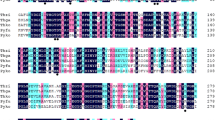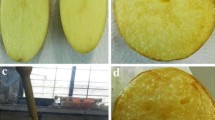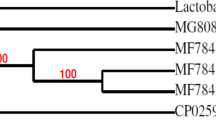Abstract
A thermostable l-asparaginase was produced from Bacillus licheniformis UDS-5 (GenBank accession number, OP117154). The production conditions were optimized by the Plackett Burman method, followed by the Box Behnken method, where the enzyme production was enhanced up to fourfold. It secreted l-asparaginase optimally in the medium, pH 7, containing 0.5% (w/v) peptone, 1% (w/v) sodium chloride, 0.15% (w/v) beef extract, 0.15% (w/v) yeast extract, 3% (w/v) l-asparagine at 50 °C for 96 h. The enzyme, with a molecular weight of 85 kDa, was purified by ion exchange chromatography and size exclusion chromatography with better purification fold and percent yield. It displayed optimal catalysis at 70 °C in 20 mM Tris–Cl buffer, pH 8. The purified enzyme also exhibited significant salt tolerance too, making it a suitable candidate for the food application. The l-asparaginase was employed at different doses to evaluate its ability to mitigate acrylamide, while preparing French fries without any prior treatment. The salient attributes of B. licheniformis UDS-5 l-asparaginase, such as greater thermal stability, salt stability and acrylamide reduction in starchy foods, highlights its possible application in the food industry.




Similar content being viewed by others
Data availability
Data available on justified request from the authors.
References
Abhini KN, Rajan AB, Fathimathu zuhara K, Sebastian D (2022) Response surface methodological optimization of l-asparaginase production from the medicinal plant endophyte Acinetobactor baumannii ZAS1. J Gen Eng Biotechnol 20:1–13. https://doi.org/10.1186/s43141-022-00309-4
Akgun B, Arici M, Canvus F, Karatas AB, Eksi Karaagac H, Ucurum HO (2021) Application of l-asparaginase to produce high-quality Turkish coffee and the role of precursors in acrylamide formation. J Food Process Preserv 45:15486. https://doi.org/10.1111/jfpp.15486
Alam S, Ahmad R, Pranaw K, Mishra P, Khare SK (2018) Asparaginase conjugated magnetic nanoparticles used for reducing acrylamide formation in food model system. Bioresour Technol 269:121–126. https://doi.org/10.1016/j.biortech.2018.08.095
Alam S, Pranaw K, Tiwari R, Khare SK (2019) Recent development in the uses of asparaginase as food enzyme. In: Parameswaran B, Varjani S, Raveendran S (eds) Green bio-processes: enzymes in industrial food processing, 1st edn. Springer, Singapore, pp 55–81
Alam S, Nagpal T, Singhal R, Khare SK (2021) Immobilization of l-asparaginase on magnetic nanoparticles: kinetics and functional characterization and applications. Bioresour Technol 339:125599. https://doi.org/10.1016/j.biortech.2021.125599
Antunes-Rohling A, Ciudad-Hidalgo S, Mir-Bel J, Raso J, Cebrián G, Álvarez I (2018) Ultrasound as a pretreatment to reduce acrylamide formation in fried potatoes. Innov Food Sci Techno 49:158–169. https://doi.org/10.1016/j.ifset.2018.08.010
Badoei-Dalfard A (2015) Purification and characterization of l-asparaginase from Pseudomonas aeruginosa strain SN004: production optimization by statistical methods. Biocatal Agric Biotechnol 4:388–397. https://doi.org/10.1016/j.bcab.2015.06.007
Baskar G, Aiswarya R (2018) Overview on mitigation of acrylamide in starchy fried and baked foods: acrylamide mitigation in starchy fried and baked foods. J Sci Food Agric 98:4385–4394. https://doi.org/10.1002/jsfa.9013
Batool T, Makky EA, Jalal M, Yusoff MM (2016) A comprehensive review on l-asparaginase and its applications. Biotechnol Appl Biochem 178:900–923. https://doi.org/10.1007/s12010-015-1917-3
Beckett A, Gervais D (2019) What makes a good new therapeutic l-asparaginase? World J Microbiol Biotechnol 35:152. https://doi.org/10.1007/s11274-019-2731-9
Bhagat J, Kaur A, Chadha BS (2016) Single step purification of asparaginase from endophytic bacteria Pseudomonas oryzihabitans exhibiting high potential to reduce acrylamide in processed potato chips. Food Bioprod Process 99:222–230. https://doi.org/10.1016/j.fbp.2016.05.010
Castro D, Marques ASC, Almeida MR, de Paiva GB, Bento HB, Pedrolli DB, Freire MG, Tavares AP, Santos-Ebinuma VC (2021) l-asparaginase production review: bioprocess design and biochemical characteristics. Appl Microbiol Biotechnol 105:4515–4534. https://doi.org/10.1007/s00253-021-11359-y
Chand S, Mahajan RV, Prasad JP, Sahoo DK, Mihooliya KN, Dhar MS, Sharma G (2020) A comprehensive review on microbial l-asparaginase: bioprocessing, characterization, and industrial applications. Biotechnol Appl Biochem 67:619–647. https://doi.org/10.1002/bab.1888
Chohan SM, Rashid N, Sajed M, Imanaka T (2019) Pcal_0970: an extremely thermostable l-asparaginase from Pyrobaculum calidifontis with no detectable glutaminase activity. Folia Microbiol 64:313–320. https://doi.org/10.1007/s12223-018-0656-6
Corral P, Amoozegar MA, Ventosa A (2019) Halophiles and their biomolecules: recent advances and future applications in biomedicine. Mar Drugs 18:33. https://doi.org/10.3390/md18010033
Corrêa CLO, das Merces Penha E, Dos Anjos MR, Pacheco S, Freitas-Silva O, Luna AS, Gottschalk LMF (2021) Use of asparaginase for acrylamide mitigation in coffee and its influence on the content of caffeine, chlorogenic acid, and caffeic acid. Food Chem 338:128045. https://doi.org/10.1016/j.foodchem.2020.128045
da Silva LF, de Pádua APSL, de Oliveira FL, Agamez-Montalvo GS, Bezerra JDP, Moreira KA, de Souza-Motta CM (2022) Cacti as low-cost substrates to produce l-asparaginase by endophytic fungi. World J Microbiol Biotechnol 38:247. https://doi.org/10.1007/s11274-022-03420-3
Daniali G, Jinap S, Sanny M, Tan CP (2018) Effect of amino acids and frequency of reuse frying oils at different temperature on acrylamide formation in palm olein and soy bean oils via modeling system. Food Chem 245:1–6. https://doi.org/10.1016/j.foodchem.2017.10.070
Darvishi F, Faraji N, Shamsi F (2019) Production and structural modeling of a novel asparaginase in Yarrowia lipolytica. Int J Biol Macromol 125:955–961. https://doi.org/10.1016/j.ijbiomac.2018.12.162
Desai RP, Dave D, Suthar SA, Shah S, Ruparelia N, Kikani BA (2021) Immobilization of α-amylase on GO-magnetite nanoparticles for the production of high maltose containing syrup. Int J Biol Macromol 169:228–238. https://doi.org/10.1016/j.ijbiomac.2020.12.101
Doriya K, Kumar DS (2018) Optimization of solid substrate mixture and process parameters for the production of l-asparaginase and scale-up using tray bioreactor. Biocatal Agric Biotechnol 13:244–250. https://doi.org/10.1016/j.bcab.2018.01.004
El-Naggar NE-A, Deraz SF, El-Ewasy SM, Suddek GM (2018) Purification, characterization and immunogenicity assessment of glutaminase free l-asparaginase from Streptomyces brollosae NEAE-115. BMC Pharmacol Toxicol 19:51. https://doi.org/10.1186/s40360-018-0242-1
Farahat MG, Amr D, Galal A (2020) Molecular cloning, structural modeling and characterization of a novel glutaminase-free l-asparaginase from Cobetia amphilecti AMI6. Int J Biol Macromol 143:685–695. https://doi.org/10.1016/j.ijbiomac.2019.10.258
Freisling H, Slimani N (2015) Challenges in estimating dietary acrylamide intake. In: Gokmen V (ed) Acrylamide in food: analysis, content and potential health effects. Elsevier, Amsterdam, pp 19–37
Granvogl M, Schieberle P (2006) Thermally generated 3-aminopropionamide as a transient intermediate in the formation of acrylamide. J Agric Food Chem 54:5933–5938. https://doi.org/10.1021/jf061150h
Haki G, Rakshit SK (2003) Developments in industrially important thermostable enzymes: a review. Bioresour Technol 89:17–34. https://doi.org/10.1016/S0960-8524(03)00033-6
Hong SJ, Lee YH, Khan AR, Ullah I, Lee C, Park CK, Shin JH (2014) Cloning, expression, and characterization of thermophilic l-asparaginase from Thermococcus kodakarensis KOD1. J Basic Microbiol 54:500–508. https://doi.org/10.1002/jobm.201300741
Jia M, Xu M, He B, Rao Z (2013) Cloning, expression, and characterization of l-Asparaginase from a newly isolated Bacillus subtilis B11–06. J Agric Food Chem 61:9428–9434. https://doi.org/10.1021/jf402636w
Jia R, Wan X, Geng X, Xue D, Xie Z, Chen C (2021) Microbial l-asparaginase for application in acrylamide mitigation from food: current research status and future perspectives. Microorganisms 9:1659. https://doi.org/10.3390/microorganisms9081659
Jiao L, Chi H, Lu Z, Zhang C, Chia SR, Show PL, Tao Y, Lu F (2020) Characterization of a novel type I l-asparaginase from acinetobacter soli and its ability to inhibit acrylamide formation in potato chips. J Biosci Bioeng 129:672–678. https://doi.org/10.1016/j.jbiosc.2020.01.007
Johnantan C, Vaz T, Guidini CZ (2021) l-asparaginase: therapeutic use and applications in the food industry—a review. Res Soc Dev 10:1–26. https://doi.org/10.33448/rsd-v10i10.18980
Khalil NM, Rodríguez-Couto S, El-Ghany MNA (2021) Characterization of Penicillium crustosum l-asparaginase and its acrylamide alleviation efficiency in roasted coffee beans at non-cytotoxic levels. Arch Microbiol 203:2625–2637. https://doi.org/10.1007/s00203-021-02198-6
Kikani BA, Singh SP (2011) Single step purification and characterization of a thermostable and calcium independent α-amylase from Bacillus amyloliquifaciens TSWK1-1 isolated from Tulsi Shyam hot spring reservoir, Gujarat (India). Int J Biol Macromol 48:676–681. https://doi.org/10.1016/j.ijbiomac.2011.02.010
Kikani BA, Singh SP (2015) Enzyme stability, thermodynamics and secondary structures of α-amylase as probed by the CD spectroscopy. Int J Biol Macromol 81:450–460. https://doi.org/10.1016/j.ijbiomac.2015.08.032
Kikani BA, Singh SP (2022) Amylases from thermophilic bacteria: structure and function relationship. Crit Rev Biotechnol 42:325–341. https://doi.org/10.1080/07388551.2021.1940089
Kikani BA, Kourien S, Rathod U (2020) Stability and thermodynamic attributes of starch hydrolyzing α-amylase of Anoxybacillus rupiensis TS-4. Starch-Stärke 72:1900105. https://doi.org/10.1002/star.201900105
Koszucka A, Nowak A, Nowak I, Motyl I (2020) Acrylamide in human diet, its metabolism, toxicity, inactivation and the associated European Union legal regulations in food industry. Crit Rev Food Sci Nutr 60:1677–1692. https://doi.org/10.1080/10408398.2019.1588222
Krishnapura PR, Belur PD, Subramanya S (2015) A critical review on properties and applications of microbial l -asparaginases. Crit Rev Microbiol 42:720–737. https://doi.org/10.3109/1040841X.2015.1022505
Kumar J, Das S, Teoh SL (2018) Dietary acrylamide and the risks of developing cancer: facts to ponder. Front Nutr 5:323710. https://doi.org/10.3389/fnut.2018.00014
Martinez E, Rodriguez JA, Mondragon AC, Lorenzo JM, Santos EM (2019) Influence of potato crisps processing parameters on acrylamide formation and bioaccesibility. Molecules 24:3827. https://doi.org/10.3390/molecules24213827
Meghavarnam AK, Janakiraman S (2018) Evaluation of acrylamide reduction potential of l-asparaginase from Fusarium culmorum (ASP-87) in starchy products. LWT 89:32–37. https://doi.org/10.1016/j.lwt.2017.09.048
Mohan Kumar NS, Manonmani HK (2013) Purification, characterization and kinetic properties of extracellular l-asparaginase produced by Cladosporium sp. World J Microbiol Biotechnol 29:577–587. https://doi.org/10.1007/s11274-012-1213-0
Mohan Kumar NS, Shimray CA, Indrani D, Manonmani HK (2014) Reduction of acrylamide formation in sweet bread with l-Asparaginase treatment. Food Bioprocess Technol 7:741–748. https://doi.org/10.1007/s11947-013-1108-6
Mottram DS, Wedzicha BL, Dodson AT (2002) Acrylamide is formed in the Maillard reaction. Nature 419:448–449. https://doi.org/10.1038/419448a
Mukherjee R, Bera D (2022) Statistical optimization of asparaginase production by a novel isolated bacterium Brevibacillus borstelensis ML12 using Plackett-Burman design and response surface methodology. J Appl Biol Biotechnol 10:12–21. https://doi.org/10.7324/JABB.2022.100303
Munir N, Zia MA, Sharif S, Tahir IM, Jahangeer M, Javed I, Riaz M, Sarwar MU, Akram M, Shah SMA (2019) L-Asparaginase potential in acrylamide mitigation from foodstuff: a mini-review. Prog Nutr 21:498–506. https://doi.org/10.23751/pn.v21i3.6771
Onishi Y, Prihanto AA, Yano S, Takagi K, Umekawa M, Wakayama M (2015) Effective treatment for suppression of acrylamide formation in fried potato chips using L-asparaginase from Bacillus subtilis. 3 Biotech 5:783–789. https://doi.org/10.1007/s13205-015-0278-5
Oza VP, Parmar PP, Patel DH, Subramanian RB (2011) Cloning, expression and characterization of l-asparaginase from Withania somnifera L. for large scale production. 3 Biotech 1:21–26. https://doi.org/10.1007/s13205-011-0003-y
Parashiva J, Nuthan BR, Bharatha M, Praveen R, Tejashwini P, Satish S (2023) Response surface methodology based optimized production, purification, and characterization of l-asparaginase from Fusarium foetens. World J Microbiol Biotechnol 39:1–15. https://doi.org/10.1007/s11274-023-03684-3
Patel P, Gosai H, Panseriya H, Dave B (2021) Development of process and data centric inference system for enhanced production of l-asparaginase from halotolerant Bacillus licheniformis PPD37. Biotechnol Appl Biochem 1:1–23. https://doi.org/10.1007/s12010-021-03707-5
Paul V, Tiwary BN (2020) An investigation on the acrylamide mitigation potential of l-asparaginase from BV-C strain. Biocatal Agric Biotechnol 27:101677. https://doi.org/10.1016/j.bcab.2020.101677
Qeshmi FI, Homaei A, Fernandes P, Javadpour S (2018) Marine microbial l-asparaginase: biochemistry, molecular approaches and applications in tumor therapy and in food industry. Microbiol Res 208:99–112. https://doi.org/10.1016/j.micres.2018.01.011
Sanghvi G, Bhimani K, Vaishnav D, Oza T, Dave G, Kunjadia P, Sheth N (2016) Mitigation of acrylamide by l-asparaginase from Bacillus subtilis KDPS1 and analysis of degradation products by HPLC and HPTLC. Springer plus 5:533. https://doi.org/10.1186/s40064-016-2159-8
Shi R, Liu Y, Mu Q, Jiang Z, Yang S (2017) Biochemical characterization of a novel l-asparaginase from Paenibacillus barengoltzii being suitable for acrylamide reduction in potato chips and mooncakes. Int J Biol Macromol 96:93–99. https://doi.org/10.1016/j.ijbiomac.2016.11.115
Shipp A, Lawrence G, Gentry R, McDonald T, Bartow H, Bounds J, Macdonald N, Clewell H, Allen B, Van Landingham C (2006) Acrylamide: review of toxicity data and dose-response analyses for cancer and noncancer effects. Crit Rev Toxicol 36:481–608. https://doi.org/10.1080/10408440600851377
Shirazian P, Asad S, Amoozegar MA (2016) The potential of halophilic and halotolerant bacteria for the production of antineoplastic enzymes: L-asparaginase and L-glutaminase. EXCLI J 15:268. https://doi.org/10.17179/excli2016-146
Silva LF, Freire KT, Araújo-Magalhães GR, Agamez-Montalvo GS, Sousa MA, Costa-Silva TA, Paiva LM, Pessoa-Junior A, Bezerra JD, Souza-Motta CM (2018) Penicillium and Talaromyces endophytes from Tillandsia catimbauensis, a bromeliad endemic in the Brazilian tropical dry forest, and their potential for l-asparaginase production. World J Microbiol Biotechnol 34:1–12. https://doi.org/10.1007/s11274-018-2547-z
Soliman HM, El-Naggar NEA, El-Ewasy SM (2020) Bioprocess optimization for enhanced production of L-asparaginase via two model-based experimental designs by alkaliphilic Streptomyces fradiae NEAE-82. Curr Biotechnol 9:23–37. https://doi.org/10.2174/2211550109666200206100445
Stadler RH, Blank I, Varga N, Robert F, Hau J, Guy PA, Robert MC, Riediker S (2002) Acrylamide from Maillard reaction products. Nature 419:449–450. https://doi.org/10.1038/419449a
Sudhir AP, Agarwaal VV, Dave BR, Patel DH, Subramanian RB (2016) Enhanced catalysis of l-asparaginase from Bacillus licheniformis by a rational redesign. Enz Microb Technol 86:1–6. https://doi.org/10.1016/j.enzmictec.2015.11.010
Sun Z, Qin R, Li D, Ji K, Wang T, Cui Z, Huang Y (2016) A novel bacterial type II l-asparaginase and evaluation of its enzymatic acrylamide reduction in French fries. Int J Biol Macromol 92:232–239. https://doi.org/10.1016/j.ijbiomac.2016.07.031
Vinci RM, Mestdagh F, De Meulenaer B (2012) Acrylamide formation in fried potato products–present and future, a critical review on mitigation strategies. Food Chem 133:1138–1154. https://doi.org/10.1016/j.foodchem.2011.08.001
Wang Y, Wu H, Zhang W, Xu W, Mu W (2021) Efficient control of acrylamide in French fries by an extraordinarily active and thermo-stable l-asparaginase: a lab-scale study. Food Chem 360:130046. https://doi.org/10.1016/j.foodchem.2021.130046
Xu F, Oruna-Concha MJ, Elmore JS (2016) The use of asparaginase to reduce acrylamide levels in cooked food. Food Chem 210:163–171. https://doi.org/10.1016/j.foodchem.2016.04.105
Yassin MA, Shindia A, Labib M, Soud M, El-Sayed ASA (2022) Thermostable Chitosan-l-Asparaginase conjugate from Aspergillus fumigatus is a novel structurally stable composite for abolishing acrylamide formation in French fried potatoes. LWT 162:113494. https://doi.org/10.1016/j.lwt.2022.113494
Yim S, Kim M (2019) Purification and characterization of thermostable l-asparaginase from Bacillus amyloliquefaciens MKSE in Korean soybean paste. LWT 109:415–421. https://doi.org/10.1016/j.lwt.2019.04.050
Yuan B, Ma P, Fan Y, Guan B, Hu Y, Zhang Y, Yan W, Li X, Ni Y (2022) Construction of l-Asparaginase stable mutation for the application in food acrylamide mitigation. Fermentation 8:218. https://doi.org/10.3390/fermentation8050218
Zhang S, Xie Y, Zhang C, Bie X, Zhao H, Lu F, Lu Z (2015) Biochemical characterization of a novel l-asparaginase from Bacillus megaterium H-1 and its application in French fries. Food Res Int 77:527–533. https://doi.org/10.1016/j.foodres.2015.08.031
Zuo S, Zhang T, Jiang B, Mu W (2015) Reduction of acrylamide level through blanching with treatment by an extremely thermostable l-asparaginase during French fries processing. Extremophiles 19:841–851. https://doi.org/10.1007/s00792-015-0763-0
Zyzak DV, Sanders RA, Stojanovic M, Tallmadge DH, Eberhart BL, Ewald DK, Gruber DC, Morsch TR, Strothers MA, Rizzi GP (2003) Acrylamide formation mechanism in heated foods. J Agric Food Chem 51:4782–4787. https://doi.org/10.1021/jf034180i
Acknowledgements
All the authors acknowledge Charotar University of Science and Technology, Changa for the financial and infrastructural support. The authors also acknowledge Dr. Avinash Mishra, Senior Principal Scientist, CSIR-Central Salt and Marine Chemicals Research Institute (CSIR-CSMCRI), Bhavnagar for the technical inputs.
Funding
DJ acknowledges financial assistance in terms of CHARUSAT PhD Scholars’ Fellowship (CPSF) by CHARUSAT, Changa (CHARUSAT/Admn/02/2020/126.04, Dated 6/2/2020) and ScHeme Of Developing High quality research (SHODH) (Reference Number 202001300007, Dated 1/7/2021) by Department of Education, Government of Gujarat, Gandhinagar. SS also acknowledges financial assistance in terms of CHARUSAT PhD Scholars’ Fellowship (CPSF) by CHARUSAT, Changa and ScHeme Of Developing High quality research (SHODH) (Reference Number 202001300010, Dated 1/7/2021) by Department of Education, Government of Gujarat, Gandhinagar. HP acknowledges financial assistance in terms of CHARUSAT PhD Scholars’ Fellowship (CPSF) (CHARUSAT/ADM/URC/21/11/1548, Dated 15/11/2021) by CHARUSAT, Changa.
Author information
Authors and Affiliations
Contributions
DP conceived the idea and involved in the experiment design, and edited the manuscript; BK conceived idea, conducted experimental design, data analysis, preparation and edited manuscript; DJ assisted in experimental design, executed the experiments and interpreted data; SS isolated the bacterium, assisted in the experiments and data analysis; HP assisted in HPLC experiments and data analysis. All the authors have reviewed the manuscript and approve for its submission to the World Journal of Microbiology and Biotechnology.
Corresponding authors
Ethics declarations
Competing interests
The authors declare no competing interests.
Research involving human participants and/or animals
This article does not contain any studies with human participants and/ or animals performed by any of the authors.
Additional information
Publisher's Note
Springer Nature remains neutral with regard to jurisdictional claims in published maps and institutional affiliations.
Supplementary Information
Below is the link to the electronic supplementary material.
Rights and permissions
Springer Nature or its licensor (e.g. a society or other partner) holds exclusive rights to this article under a publishing agreement with the author(s) or other rightsholder(s); author self-archiving of the accepted manuscript version of this article is solely governed by the terms of such publishing agreement and applicable law.
About this article
Cite this article
Joshi, D., Patel, H., Suthar, S. et al. Evaluation of the efficiency of thermostable l-asparaginase from B. licheniformis UDS-5 for acrylamide mitigation during preparation of French fries. World J Microbiol Biotechnol 40, 92 (2024). https://doi.org/10.1007/s11274-024-03907-1
Received:
Accepted:
Published:
DOI: https://doi.org/10.1007/s11274-024-03907-1




